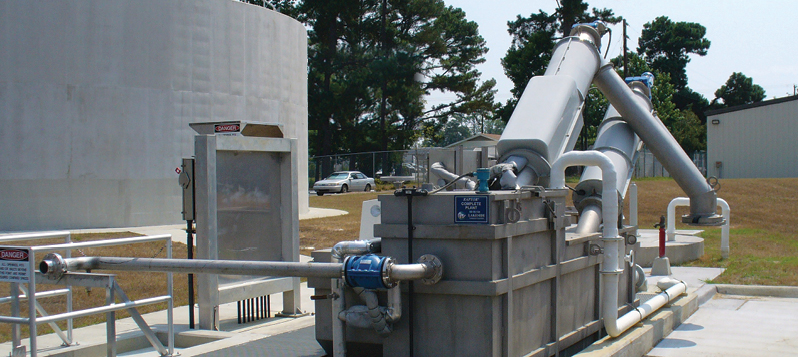Wastewater is one of the most common forms of pollution, and in the United States there are wastewater treatment facilities to control this. According to the Environmental Protection Agency (EPA), wastewater contains large solids and grit that can interfere with treatment processes or cause undue mechanical wear. Over time, this increases maintenance on wastewater treatment equipment. In order to minimize problems, these materials require separate and special handling and maintenance. The EPA recognizes preliminary forms of wastewater treatment as screening, grit removal, septage handling, odor control, and flow equalization. Facilities that clean wastewater, such as water treatment centers clean it before discharging it back into the environment. This can be done with machinery (both manual and mechanical). Machinery that has been especially engineered for wastewater treatment is most efficient. Let’s take a deeper look at some of the ways wastewater screening works.
Wastewater Screening Devices
In general, wastewater screening devices are classified based on the amount of material that is being removed from them. The design elements that classify screening equipment are size, depth, width, the screen’s angle, approach velocity of the channel, the discharge height, wind and other aesthetic considerations. There are different types of screening devices, both manual and mechanical.
There are different types of wastewater screens which include coarse screens, fine screens, and communitors and grinders (which are typically used at a smaller treatment facility). Screens can be made of a simple trash rack, or can be as complex as a mechanical bar system. There are also hydrocyclone systems which are devices used to separate liquids from solids, or grit from sludge, directly from the wastewater. The EPA identifies the specifications for the screens below:
Coarse Screens – Coarse screens remove large solids, rags, and debris from wastewater, and typically have openings of 6 mm (0.25 in) or larger.
Fine Screens -Fine screens are typically used to remove material that may create operation and maintenance problems in downstream processes, particularly in systems that lack primary treatment. Typical opening sizes for fine screens are 1.5 to 6 mm (0.06 to 0.25 in). Very fine screens with openings of 0.2 to 1.5 mm (0.01 to 0.06 in).
Communitors and Grinders – Comminuting and grinding devices (which consist of rotating slotted cylinders) are installed in the wastewater flow channel to grind and shred material up to 6 to 19 mm (0.25 to 0.75 in) in size
Hydrocyclone Systems – This is a system that separates liquids from solids directly from the wastewater. Heavier grit and suspended solids collect on the sides and bottom of the cyclone, while scum and lighter solids are removed from the center through the top of the cyclone.
Manual and Mechanical Screening Equipment
There are both manually cleaned and mechanically cleaned bar screens. A bar screen is essentially a heavy duty screen that uses a reciprocating rake which cleans the wastewater bar screen by pulling out debris.
In general, manually cleaned screens will require frequent raking to avoid them getting clogged up. This also avoids a buildup of solids on the screen itself and backwater levels from rising. Keep in mind that this manual work will require more labor costs over time. The time that is taken to clean the screen manually will also detract from the time it is serving its purpose, which can also cause overflow of waste solids.
Mechanical screens, on the other hand, aren’t subject to the same concerns, but they do require higher maintenance costs. Overall, you want to make sure you have a system that is the most efficient for your facility and needs. The Environmental Protection Agency suggests that plants utilizing mechanically cleaned screens should have a standby screen to put into operation when the primary screening device is out of service — which is a standard design practice for many newly designed plants. Having a replacement screen will prevent clogging and backup, similarly to concerns for when a manual screen is being cleaned. Larger facilities are more likely to use a mechanical screen in order to reduce labor costs (as the equipment is more costly itself), and to improve the conditions of the overall flow of the wastewater and water treatment process. The cost for screens varies, of course, depending on the technology that is used and that is available in each particular area.
Efficient Wastewater Equipment
Our wastewater treatment equipment is efficient in that it screens, washes, compacts and dewaters in one smooth, seamless operation. This equipment is designed to handle wastewater, septage, sludge, scum, and grease. Our equipment offers:
- Compact design with screening and grit removal in one unit
- Security control station allows access for authorized haulers
- All stainless steel construction resists corrosion
- Available for indoor or outdoor environments
- Multiple sized units to suit your application
- Unload up to two (2) waste haulers at the same time
Selecting A Wastewater Treatment System
When considering a wastewater treatment system, you want to select one that is appropriate for your needs. Keep in mind your location, facility, anticipated costs, the size of the system, and its overall functioning. One of the most important components of a water treatment system is the screen. As discussed, screens come in different sizes, depths, widths, and different designs according to the technology available in the area as well as for your budget. Overall, mechanical screens are commonly used in larger treatment facilities and require lower labor costs. No matter what type of equipment you choose, it is important to have a backup screen so your operations can run smoothly, avoiding backup and unnecessary problems. If you are looking for a water treatment system, take a look at our specially engineered equipment with quality materials which has been made to maximize efficiency and minimize setbacks.








